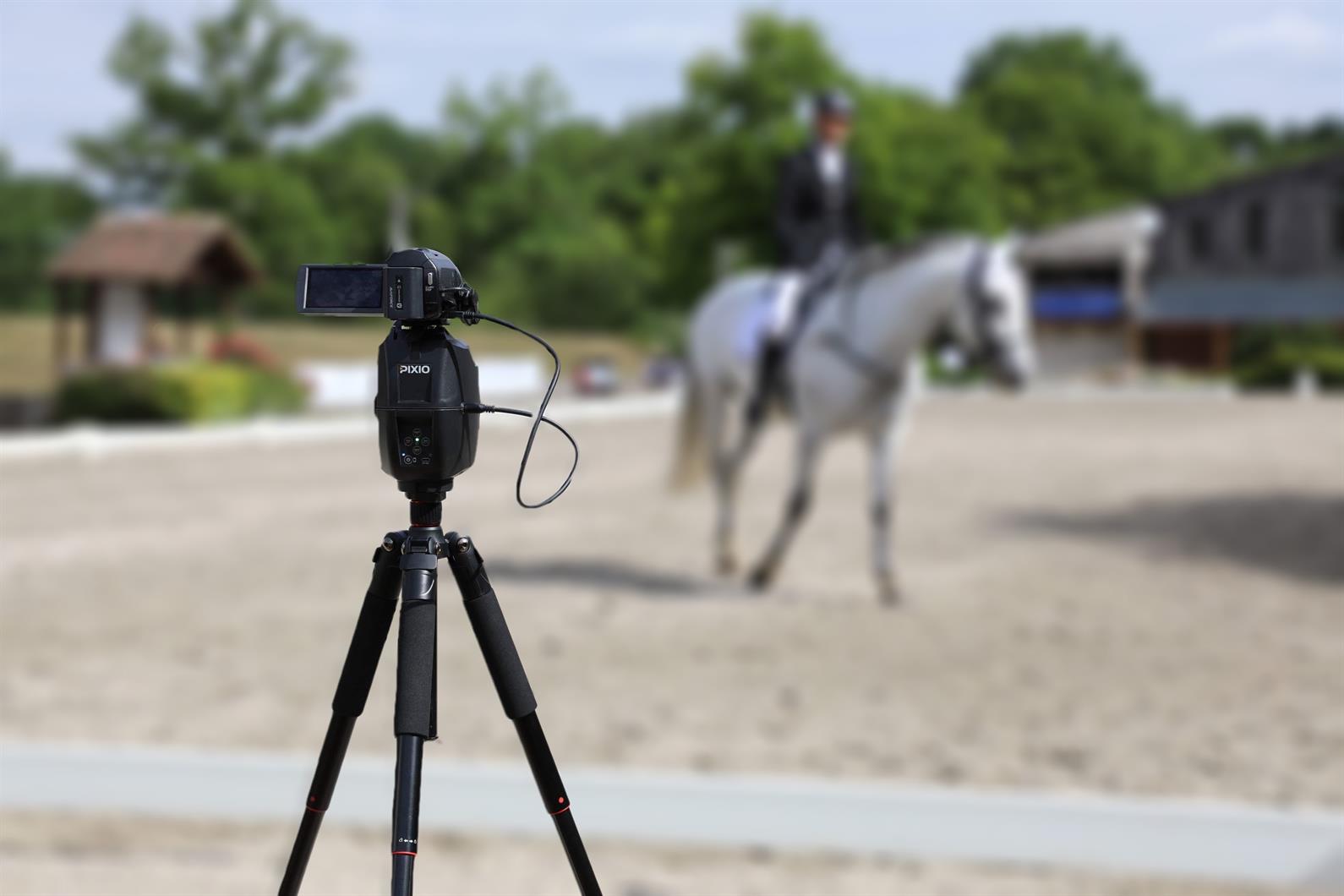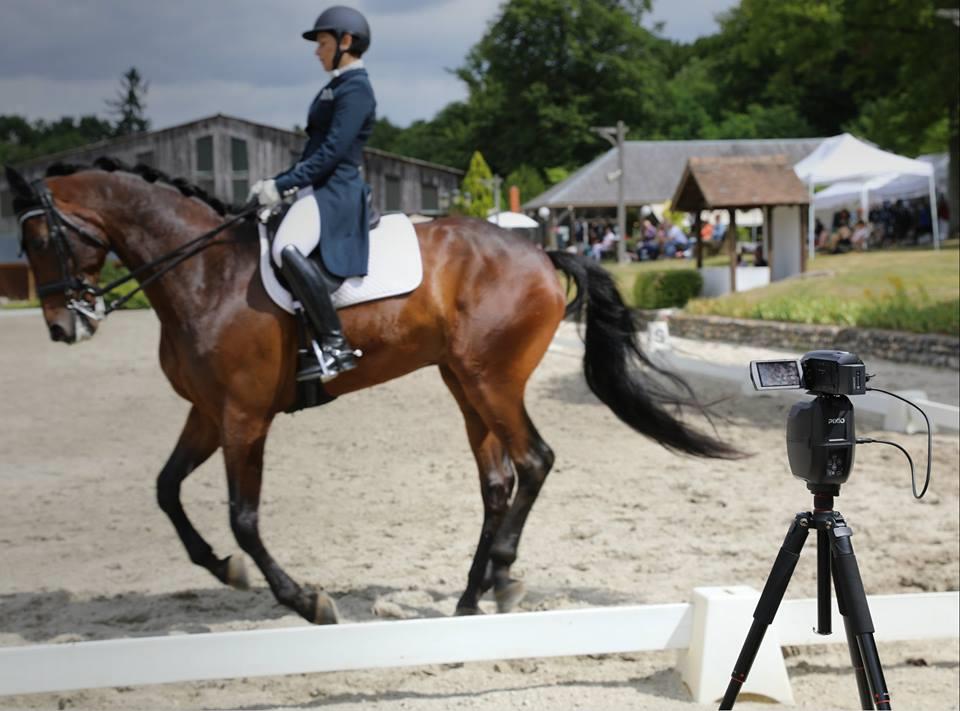Move ’N See’s PIXIO and PIXEM auto-follow cameras have been game-changers for many equestrians. These robot cameramen automatically track and zoom in or out on a rider wearing a wristband watch as they train, allowing equestrians to review their rides and even train live with a remote coach using the live-coaching service. But they’re also useful tools for making a video to market a horse for sale.
How PIXIO and PIXEM Work

Photo: Courtesy of Move 'N See
“PIXIO and PIXEM are robot cameraman that automatically track and zoom in/out on the person wearing a specific tag (included in each kit) with the help of three little beacons to set up around the riding area,” explained Eric Willemenot, CEO of Move N See, which makes the camera systems. “PIXIO films with a camera mounted on top, and PIXEM with a smartphone or tablet. They can film both indoor and outdoor rides, with a range of up to 330 feet. It's also possible to have a PIXIO compatible with cameras, smartphones, and tablets by purchasing a PIXIO robot and the specific upgrade here.
“In the PIXIO and PIXEM kits, you'll receive the PIXIO or PIXEM robot, three beacons and their flexible mini-tripods for easy set-up, and a wristband watch. Each kit also includes all chargers adapted to the country of delivery. The customer can then add a tripod (or purchase one separately, as the PIXIO and PIXEM can be used with any 3/8-inch screw tripod), transport bag, and/or live coaching features. But for simple filming, you need a PIXIO, tripod, and camera or a PIXEM, tripod, and your phone, and that's it!”
The wristband watch is the tracking tag that the camera follows. If you’re taping a sale video and want the camera to focus specifically on the horse, simply secure the watch on the horse’s tack rather than on the rider’s wrist.
“PIXIO and PIXEM offer precise tracking thanks to radio communication, whereas most of the other brands work with image recognition and can lose the person or horse being filmed very often,” Le Baill said. “PIXIO can work with many big-brand cameras, such as Sony or Canon, to offer a high quality of image.”
Customers have noted PIXIO’s and PIXEM’s good tracking and image quality have improved the quality of their horse sales videos. The live coaching features can also be used for live demonstrations for potential buyers, allowing the seller to reach more clients.
French dressage trainer and competitor Nicole Favereau has used PIXEM for the market horses and says not having to worry about a good tracking or image quality has improved the quality of her videos.
“Now that I focus on the horse, I feel like the videos are smoother, more natural, and more interesting for buyers to watch!” Favereau said. “Sometimes I even use the one-on-one live lesson service to do a live demonstration to a potential buyer. Or I film and edit the video from my phone and send it or post it on a sales website directly.”
10 Tips for Sale Videos
Using a camera that offers high-quality footage, like a Sony, Canon, or late-model cell phone, is a good starting point. Once you’ve lined up your camera and set up the

robot camera system, there are other steps you can take to make your horse sale video stand out—and help potential buyers see your horse’s best qualities.
Film outside if possible.
You’re more likely to get good light outdoors than in an arena. Early morning or late afternoon offer the best light and are often preferred by video pros. A slightly overcast day also is good, so don’t worry if your video days dawns cloudy.
Choose a quiet location with no background clutter.
A quiet, uncluttered area will help prevent your horse—and the video’s audience—from getting distracted. Remember to keep barn pets contained, too, if they might be inclined to interrupt your shoot.
Do a test run.
A practice taping will help you identify any trouble spots with location or lighting and allow you to adjust.
Neat, clean turnout is a must.
Make sure horse and rider both are neat and well-groomed. Present the horse as if for a show, though you need not braid, and it’s best to keep equine boots off to allow the audience a good view of the horse’s legs. Tack should be cleaned.
Keep it short.
When editing your video, prioritizing the ring’s long sides, rather than the turns, can help you show off your horse’s gaits to the best advantage. Videos with a total time of two to five minutes are useful to show off a variety of gaits and performance. Don’t spend too long showing a single gait, as it will tempt viewers to disengage.
Start with your horse’s best gait.
Edit to put your horse’s best gait up front. That helps attract buyers’ attention early and keep them wanting more.
Show the horse working in both directions.
Consider including conformation shots.
These can either be still images edited into the video or video images taped from each side, front, and back. They are a useful overview for your potential buyer.
Keep sound and text unobtrusive.
A lot of sounds and text can be distracting. Keep them to a minimum. If you use music, use understated, royalty-free tunes—and keep the volume quiet.
Consider taping the horse being handled.
Including clips, or a brief second video, of the horse in everyday situations—such as loading onto a trailer, being clipped, or standing for a farrier—can help show off good temperament and personality.
Learn more about the PIXIO and PIXEM systems here. USEF members are eligible for a discount and can access a complimentary six-month Live Lesson subscription package. Learn more here.


